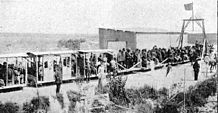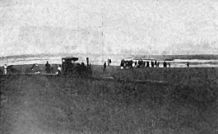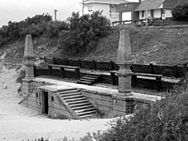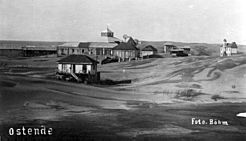Ostende, Buenos Aires facts for kids
Quick facts for kids
Ostende
|
|
|---|---|
|
City
|
|
| Country | |
| Province | |
| Partido | Pinamar |
| Founded | 1913 |
| Elevation | 14 m (46 ft) |
| Population
(2001)
|
|
| • Total | 6,073 |
| CPA Base |
B 7167
|
| Area code(s) | +54 2254 |
Ostende is a lovely seaside town on the Atlantic coast of Argentina. It's part of the Pinamar Partido area. The town is bordered by Pinamar to the north and Valeria del Mar to the south. To the east, you'll find the Argentine Sea, and to the west, the General Madariaga Partido.
Ostende is known for its wide, sandy beaches. You'll also see large dunes covered with many leafy tamarisk trees.
Contents
Discovering Ostende's Past
How Ostende's Land Was Settled
In the 1800s, the area where Ostende is today was mostly a sandy desert. It had many dunes facing the sea. These dunes were part of a large property called "Los Montes Grandes de Juancho." This land belonged to Don Martín de Alzaga, a wealthy landowner.
After Don Martín de Alzaga passed away in 1870, his wife, Felicitas Guerrero, inherited these lands. They were part of several big ranches. Later, the lands were passed down through Felicitas's family. Eventually, Héctor Manuel and Valeria Guerrero turned these wild areas into popular tourist spots.
The Founding of Ostende
Ostende was the very first town built in what is now the Pinamar Partido. It was founded by Fernando Robette from Belgium and Agustín Poli from Italy. They arrived in 1908 and bought the land. Their dream was to create a fancy seaside resort. They wanted it to be like the Belgian city of Ostend, which means "End of the East."
To reach Ostende back then, people took a train to Juancho station. From there, they rode in horse-drawn carriages to "Colonia Tokio." This was a farm where Japanese immigrants lived. Then, they boarded a special narrow-gauge railway called a Decauville. This small train traveled 3 kilometers right to the beach. The train also helped local farmers transport their goods like apples and firewood.
Once Robette settled in, he started building. He planned a dock and a hotel called "Hotel Termas." Work also began on the "Rambla Sur," a long walkway along the coast. Building was tough because of strong winds. Also, all the materials had to come from Buenos Aires by steamship.
Finally, on April 6, 1913, Ostende officially opened. A big advertising campaign helped sell land plots. Early buildings included Robette's houses, a retreat for Carmelite Monks, and Villa Adela, one of the first summer homes. A small chapel was also built, but it later disappeared due to sandstorms.
How Ostende Grew Over Time
To attract visitors, a hotel called "Hotel Termas" (later "Hotel Ostende") opened in December 1913. It had 80 rooms, plus spaces for games, reading, and even fencing. There were also restaurants, winter gardens, and a bakery.
Around this time, the Belgian founders returned to Europe, possibly because of World War I. They never came back. Many attempts to plant trees to stop the sand failed. The sand eventually buried several buildings, including the boardwalk. This showed that the early plans to control the dunes didn't work.
In 1943, Pinamar was developed as a new seaside resort. The next year, the government approved Jorge Bunge's plan for Pinamar. He successfully planted trees to fix the dunes. Bunge's ideas were based on studies by Belgian engineer Paul-Vincent Levieux and landscaper Jean-Claude Nicolas Forestier.
The original Ostende project was forgotten for a while. But on July 1, 1978, the Municipality of Pinamar was created. Ostende and other towns became part of its area.
Exploring Ostende's Tourism
Ostende's beaches are special with their natural dunes. They are covered with tamarisk trees. This makes them different from the beaches in central and northern Pinamar. Ostende is a great place for families. It's much quieter than places with busy nightlife.
Ostende is very close to the lively town of Pinamar. Because of this, Ostende feels like a peaceful "residential suburb." Tourists who want calm beaches and green spaces often choose Ostende. They can still easily access all the shops and services in Pinamar.
The small downtown area of Ostende has basic stores. You'll find grocery stores, butchers, and places for laundry or internet. Since Pinamar is so close, there's no need for many entertainment businesses in Ostende.
For places to stay, Ostende has a few hotels, inns, and apartment-style lodgings. There are also many cabin complexes and private homes for rent.
Pinamar, Ostende, Valeria del Mar, and Carilo form a connected area called the "Green Coast." This name comes from the many trees on its beaches and streets. You can easily travel between these four towns without using the main highway. This "green corridor" is also known for attracting tourists with a medium to high income.
Must-See Places in Ostende
- Viejo Hotel Ostende: This is the most famous landmark in Ostende. The founders, Robette and Poli, planned a hotel with over 80 rooms. It was first called "Hotel Termas" and later became "Hotel Ostende." Some people call it the "ghost hotel." Many writers have stayed here and found inspiration. Antoine de Saint-Exupéry, who wrote The Little Prince, wrote his first stories here. He stayed in room 51, which is now set up just as he left it for visitors to see. The hotel bar also has sketches from his work. Writers Adolfo Bioy Casares and Silvina Ocampo wrote their mystery novel Aquellos que aman, odian (Those who love, hate) here. The story takes place in the hotel. Musician Indio Solari also wrote a song called Ostende Hotel about a love story at the old hotel.
- Rambla: This boardwalk, originally "Rambla Sur," was another idea from Robette and Poli. They wanted to make the town beautiful. A company was given permission to build a boardwalk and a dock. This would help develop a European-style resort. The concrete boardwalk was designed to be 6 meters wide. It had 16 small chalets with steps leading to the beach. This area was just for tourists and had changing rooms. Construction began in 1912, using Japanese workers from "Colonia Tokio." However, World War I stopped the work. Over the years, the rambla was buried by sand. In the 1990s, it was dug up to save it. In 1995, the rambla was declared a "historical heritage" of the city. Today, it hosts cultural events in the summer.
- La Elenita: In the 1930s, Arturo Frondizi, who later became president, discovered Ostende's beaches. He built a wooden house facing the sea. This was the town's first summer home. For many years, he spent his vacations there with his family. In 1993, his niece decided to rebuild the house because it was in poor condition. The house was declared a Provincial Heritage site in 2002.
- House of Fernando Robette: This house was built by Fernando Robette, one of Ostende's founders, in 1912. When he returned to France two years later, the house was left empty. It has been abandoned ever since.
See also
 In Spanish: Ostende (Argentina) para niños
In Spanish: Ostende (Argentina) para niños







